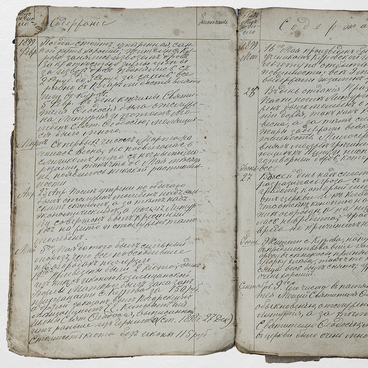Pogar is one of the oldest Russian cities. Archaeologists have reasonable grounds to believe that the first settlement in this area appeared as early as the 8th century. According to the chronicles of 1155, Pogar was known as Radogoshch. Throughout its existence, Pogar was controlled by Lithuania, then the Polish-Lithuanian Commonwealth, Ukraine, and finally the Russian Empire. A good many times it was burned by invaders, hence its name was Pogar, which meant “burnt down”.
The Pogar people mastered the crafts of shoemaking and tailoring. They were engaged in alcohol distillation. There were rich grain harvests in the area, so rye, barley, and wheat were used to make an alcoholic beverage back then known as grain wine or gorilka.
The grain wine was distilled in large quantities and sold at local markets. In the Starodubsky Regiment, which is what this place was called in the 17th century, the Cossacks and petit-bourgeois received large income from the gorilka trade, for the grain they used to produce the beverage became two or three times its worth in the process.
In his thesis, a Russian historian Sergey Biryukov wrote that, in 1693, Pogar residents Grigory Mashkovets and Pyotr Bryanchanin made a contract at the Pogar fair, stipulating that “twenty-five large barrels (1000 pails) of gorilka to be agreed upon the price of salt as 10 rubles minus a quarter and a pood of salt to be sold for 6 altyns.” The grain wine made in Starodubye was supplied to the better part of Little Russia, modern-day Eastern Ukraine. It was also exported to the neighboring territories of Lithuania and Moscow.
Nearly 70,000 pails of “grain beer” were brought to Moscow from Little Russia cities for sale in 1723. In the first half of the 18th century, there were several wine distilleries near the Sudost River. Grain wine was used as a means of payment in many trade deals. For example, petit-bourgeois Philon Korneyevich from Pogar purchased a courtyard with constructions “a barrel of gorilka for the sum of 40.2 two-kopecks and kopecks, each barrel 600 quarts”. One quart was equal to 0.9 liters.
In 1721, there were 46 shinoks (taverns) in Starodub, 21 in Pogar, and 6 in Pochep. There, grain wine was served any time of year.
The beverage was stored and transported in special pottery vessels with a cap or plug. One of those ceramic small flasks is housed by the Radogoshch Museum.
The Pogar people mastered the crafts of shoemaking and tailoring. They were engaged in alcohol distillation. There were rich grain harvests in the area, so rye, barley, and wheat were used to make an alcoholic beverage back then known as grain wine or gorilka.
The grain wine was distilled in large quantities and sold at local markets. In the Starodubsky Regiment, which is what this place was called in the 17th century, the Cossacks and petit-bourgeois received large income from the gorilka trade, for the grain they used to produce the beverage became two or three times its worth in the process.
In his thesis, a Russian historian Sergey Biryukov wrote that, in 1693, Pogar residents Grigory Mashkovets and Pyotr Bryanchanin made a contract at the Pogar fair, stipulating that “twenty-five large barrels (1000 pails) of gorilka to be agreed upon the price of salt as 10 rubles minus a quarter and a pood of salt to be sold for 6 altyns.” The grain wine made in Starodubye was supplied to the better part of Little Russia, modern-day Eastern Ukraine. It was also exported to the neighboring territories of Lithuania and Moscow.
Nearly 70,000 pails of “grain beer” were brought to Moscow from Little Russia cities for sale in 1723. In the first half of the 18th century, there were several wine distilleries near the Sudost River. Grain wine was used as a means of payment in many trade deals. For example, petit-bourgeois Philon Korneyevich from Pogar purchased a courtyard with constructions “a barrel of gorilka for the sum of 40.2 two-kopecks and kopecks, each barrel 600 quarts”. One quart was equal to 0.9 liters.
In 1721, there were 46 shinoks (taverns) in Starodub, 21 in Pogar, and 6 in Pochep. There, grain wine was served any time of year.
The beverage was stored and transported in special pottery vessels with a cap or plug. One of those ceramic small flasks is housed by the Radogoshch Museum.



